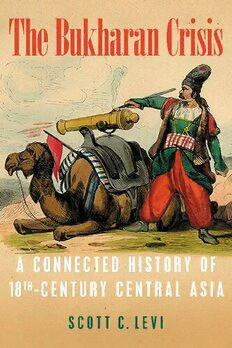
The Bukharan Crisis: A Connected History of 18th Century Central Asia PDF
Preview The Bukharan Crisis: A Connected History of 18th Century Central Asia
The Bukharan Crisis CENTRAL EURASIA IN CONTEXT SERIES Douglas Northrop, Editor A CO N N E C T E D H I S T O RY O F 18TH–C E N T U RY C E N T R A L A S I A S C O T T C . L E V I UNIVERSITY OF PITTSBURGH PRESS Published by the University of Pittsburgh Press, Pittsburgh, Pa., 15260 Copyright © 2020, University of Pittsburgh Press All rights reserved Manufactured in the United States of America Printed on acid- free paper 10 9 8 7 6 5 4 3 2 1 Cataloging-in-Publication data is available from the Library of Congress ISBN 13: 978-0-8229-4597-0 ISBN 10: 0-8229-4597-5 Cover art: “Canonnier Persan,” from Moeurs, usages et costumes de tous les peuples du monde, Auguste Wahlen. Brussels: La Librairie historique-artistique, 1843. Cover design: Joel W. Coggins To Karen, Madeleine, and Abigail CONTENTS ACKNOWLEDGMENTS ix NOTE ON GEOGRAPHIC TERMINOLOGY xiii INTRODUCTION 3 ONE BUKHARA IN CRISIS 12 TWO SILK ROADS, REAL AND IMAGINED 37 THREE THE EARLY MODERN SILK ROAD 70 FOUR THE CRISIS REVISITED 120 CONCLUSION 173 BIBLIOGRAPHY 181 INDEX 201 ACKNOWLEDGMENTS T his book emanates from a number of questions that remained unan- swered after I completed work on my first book in 2002. At that time, my research on Indian merchants in Central Asia led me to conclude that Indian commercial firms centered in and around the city of Multan developed a network that extended into Central Asia in the mid-s ixteenth century, grew dramatically in the seventeenth century, and remained in place even through the end of the nineteenth century. Turning attention to recent work in Chinese, Russian, and other related fields of history, I found additional scholarship that chipped away at the notion that early modern Central Asia sank into a lengthy period of isolation and decline as a prod- uct of the collapse of the so- called Silk Road trade (which itself is a prob- lematic concept, for reasons addressed below). Clearly, that notion needed to be reconsidered. At the same time, the Bukharan Khanate suffered a well- documented crisis in the first half of the eighteenth century. This crisis was severe, so much so that it culminated in the Bukharan Khanate’s collapse in 1747. But if the evidence indicates that the causal factor behind this crisis was not economic isolation from the early modern globalizing world, what was it? It was partly with that question in mind that I turned my attention to the history of Khoqand, a Central Asian state that began to emerge in the Ferghana Valley during the first half of the eighteenth century, at the very time that the Bukharan Khanate descended into crisis. In an effort to under- stand why it was that Khoqand came into being just as Bukhara fell, I made my way back to Tashkent to begin working in the Central Asian sources. In the United States, I explored ways to connect early modern Central Asia to larger discussions and debates in Eurasian and world history. What I had initially intended to constitute a few discreet discussions peppered throughout my book on Khoqand gradually expanded into a chapter, and then several chapters, and then this book. ix
